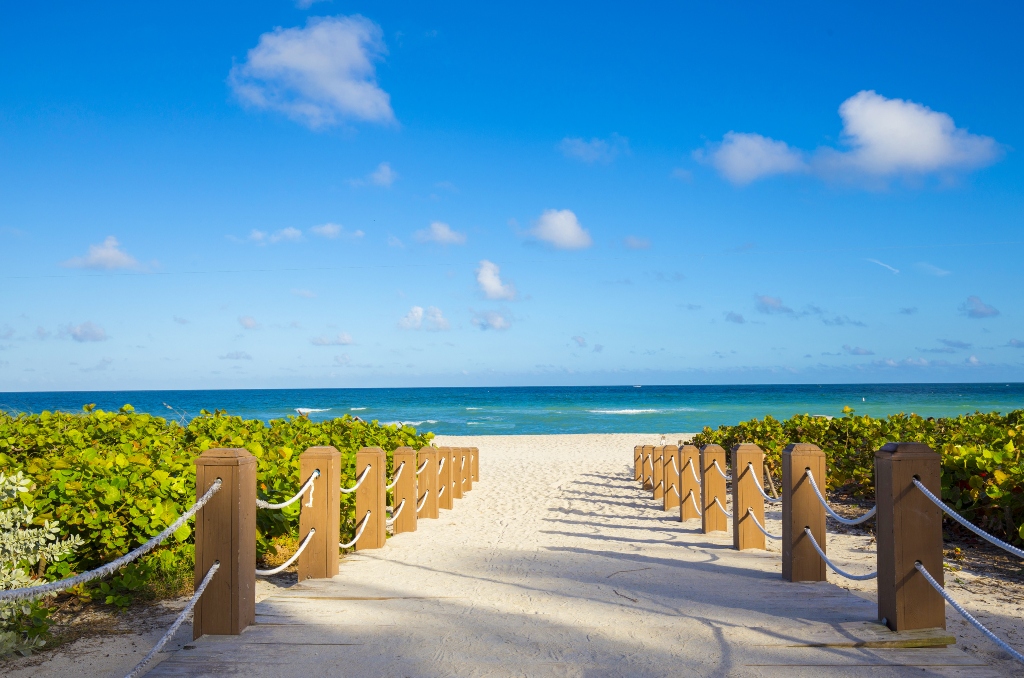Sand walkway to South Beach — Courtesy: Shutterstock — Image by: Mia2you
The Sunshine State’s beautiful sandy beaches aren’t just one of the biggest money-makers in the state’s tourism industry, they’re also the first line of defense against storm surges and flooding caused by tropical storms and hurricanes.
Now, after both coasts were hit during the 2022 hurricane season that ended on Wednesday, those specific beaches are in dire need of repair. Even prior to the start of hurricane season on June 1, 426 of the Sunshine State’s 825 miles of coastline were labeled as “critically eroded” in a June report posted by Florida’s Department of Environmental Protection.
Then, hurricanes Nicole and Ian delivered a double whammy of beach-shredding waves and wind. The damage to these beaches was immense, particularly along the northeast Florida coast.
“Our dune system is a coastal protection system,” said Jonathan Lord, the emergency management director for Flagler County in northeast Florida. “Because the dunes were so damaged from Ian, it didn’t take much for Nicole to further damage them and cause flooding in many neighborhoods.”
By dredging or trucking in new sand, Florida has been rebuilding its beaches for decades. But because beach-quality sand is getting more and more expensive, the process is becoming much more difficult. After decades of recurrent beach restoration initiatives, offshore sand deposits, particularly on Florida’s southeast coast, are diminishing. Sand prices are going up as local governments fight over who gets to utilize it.
“Sand is like gold,” said Michelle Hamor, the planning chief for the U.S. Army Corps of Engineers’ office in Norfolk, Virginia, which is leading the effort to develop a $6 billion plan to protect Miami-Dade County from storm surge. “There are a lot of projects that rely on it, and it’s a limited resource.”
The scarcity of sand
There are large amounts of sand sitting in shallow water on the continental shelf that surrounds the Sunshine State. However, not all of it meets the standards for the state’s beaches. The sea turtles that make their nests along the Florida coast can be harmed by sand that is the wrong color or grain type.
There are also financial factors to take into account. Florida spends billions of dollars each year luring tourists to its gorgeous, white-sand beaches. Filling the coastline with sand of lower quality can reduce the state’s appeal as a vacation spot.
According to the National Beach Nourishment Database created by the American Shore and Beach Preservation Association and the Army Corps, Florida has dredged or dug up over half a trillion tons of high-quality sand since 1935 to sustain its crumbling beaches. According to Stephen Leatherman, a professor of coastal science at Florida International University, the state’s supply of high-quality sand is running low and won’t be replenished any time soon.
“For all practical purposes, they’re used up,” Leatherman said. Existing sand is difficult to use and new sand takes over thousands of years to form. Once beach-quality sand gets eroded from the shoreline, it ends up scattered throughout the continental shelf in skimpy layers that are too thin to re-dredge.
Make sure you are staying up-to-date with the latest and most important Florida news with Florida Insider. Whether you are interested in business, education, government, history, sports, real estate, nature, weather, or travel: we have something for everyone. Follow along for the best stories in the Sunshine State.

Born and raised in South Florida, Krystal is a recent graduate from the University of Miami with professional writing experience at the collegiate and national news outlet levels. She’s a foodie who loves all things travel, the beach, & visiting new places throughout Florida.

